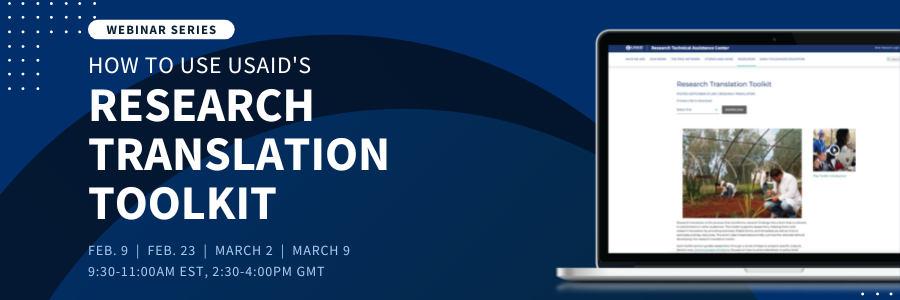The Research Translation Toolkit is particularly relevant to those supporting or implementing research projects who can benefit from step-by-step guidance on communicating key messages to the right decisionmakers.
- Section one, Communication Products, focuses on how to write a factsheet or policy brief.
- Section two, Stakeholder Analysis, focuses on identifying, prioritizing, and tracking engagement with stakeholders that can be influential in using research to impact programs, policy, and practice in a sector.
- Section three, Research-to-Action (R2A) Plan, guides readers through the development of a plan designed to accomplish r
RTAC (2021) Communication Products Section guide 51 p.
communicate research insights or technical innovation to different audiences in an accessible, compelling way that can be readily used to inform policies, programs, or practices in a particular sector.
- Step 1: Identify Communication Objectives
- Step 2: Identify Audiences
- Step 3: Identify Main Messages
- Step 4: Use Accessible Language
- Step 5: Identify Resources and Develop the Product
The section walks the users through five steps that prepare them to engage with stakeholders towards achievement of particular goals and objectives.
- Step 1: Identify Stakeholders
- Step 2: Prioritize Stakeholders
- Step 3: Understand Stakeholders
- Step 4: Plan Stakeholder Engagement
- Step 5: Track Stakeholder Engagement
This section leads users through seven steps for creating the R2A plan.
- Step 1a: Set Research-to-Action Goals
- Step 1b: Summarize Major Project Results
- Step 2: Stakeholder Analysis—Identify, Prioritize, and Engage
- Step 3: Assess the Policy Environment for Research Use: Identifying Windows of Opportunity
- Step 4: Distill Main Messages and Develop Actionable Recommendations
- Step 5: Package Research in Appropriate, User-Friendly Formats and Disseminate
- Step 6: Develop an R2A Plan Timeline and Checklist
- Step 7: Regularly Track Progress and Measure Success
Webinars
The USAID-funded Research Technical Assistance Center (RTAC) organizes a four-part webinar series that provides an overview of our Research Translation Toolkit and a deep-dive into each of its three sections. This toolkit is particularly relevant to those supporting or implementing research projects who can benefit from step-by-step guidance on communicating key messages to the right decisionmakers.
Throughout this webinar series, RTAC highlights what the toolkit is, why it is important to your work, when you can use it in the research process, and how you can use it yourself.This webinar introduced the importance of research translation – the process that transforms research findings into a form that is relevant to practitioners or other audiences – and provides a high-level overview of the Research Translation Toolkit, including real world examples of research teams that have used the processes from the toolkit.
- Speaker bios
- slides, and transcript
- video recording
- Case study highlighted during the webinar: Cooling from the Sun: Innovations for Effective Post-Harvest Cold Storage in Rural Areas of India
The information presented in this policy brief is based on research led by Dr. Sangeeta Chopra of the Indian Agricultural Research Institute (IARI) with Dr. Randolph Beaudry and Dr. Norbert Müller of Michigan State University.
23 February 2023 Reaching the Right People at the Right Time: How to Use the Stakeholder Analysis Section
- Guest Speaker: Dr. Jose Rodriguez, International Consultant, Philippines
- Speaker bios
- recording, slides, and transcript
- This webinar introduced the Stakeholder Analysis Section to identify influential individuals or groups who might use your research, and plan effective engagement with them to increase the impact of your research insights or technical innovations.
March 2 Capturing Attention: How to Use the Communication Products Section
- Guest Speakers:
- Anneka Van Scoyoc, (Population Reference Bureau (PRB), United States
- Gorrety Parmu (picture), Policy Advisor, PRB. Gorrety Parmu is a policy analyst in International Programs. She joined PRB in 2020.
- Speaker bios
- recording, slides, and transcript
- This webinar introduces you to how you can use the Communication Products Section to craft main messages and choose the right format to share your research insights or technical innovations with stakeholders in a way that motivates them to use evidence to inform policies, programs, or practices.
March 9 Transforming Research into Programs and Policies: How to Use the Research-to-Action Plan Section
- Guest Speaker: Dr. Marlene Lee, PRB, United States
- Speaker bios
- links to download the recording, slides, and transcript
- This webinar introduces you to how you can use the Research-To-Action (R2A) Plan Section to develop a step-by-step plan to communicate your research findings, attract influential stakeholders, and ensure your research leads to action.







No comments:
Post a Comment